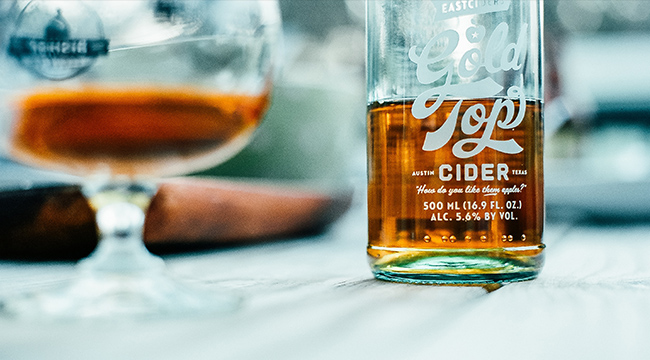
To quote the great LL Cool J, “Don’t call it a comeback. I’ve been here for years.” That phrase goes for hard cider too — a drink that’s absolutely stormed the US scene this fall. And just like LL when he dropped the hit song “Momma Said Knock You Out” way back in 1990, there was a time long ago when the apple-based alcoholic beverage was king.
Near the start of the 20th century, there was no drink more popular in America than hard cider. Thought its genesis in the US actually dates back much earlier than that…
Colonial Times
“Europeans introduced apples and cider to North American,” says Eleanor Leger, co-founder of Eden Specialty Ciders. Cider was the ubiquitous rural beverage in Colonial times as every farmhouse had an orchard. “In fact, the planting of an orchard was one of the requirements for staking a land claim during westward expansion,” she says.
During the revolutionary era, cider-making and cider appreciation were popular among all classes, with even the founding fathers debating the merits of particular apples for cider. “In the 1800s a good portion of what was sold as French champagne in New York City was actually champagne method cider from New Jersey,” says Leger.
Destroyed by prohibition
The availability of cheap cider meant that the drink was widely consumed, eventually abused, and targeted by the Temperance movement. “With prohibition, apple orchards were converted to grocery store varieties, cider apple varieties were destroyed, and commercial cider disappeared.”
Sadly, once prohibition was finally repealed the damage was done. The industrial production of beer was a much cheaper alternative to the long, drawn-out process of cider-making. Beer became and continues to be the beverage of choice in the US.
https://www.instagram.com/p/BnkDqJpHFIN/?tagged=edenspecialtyciders
A new rise in popularity
That’s slowly beginning to change, as craft cideries are beginning to pop up all over the country. “Like craft beer before it, vibrant local craft cidery scenes have gotten people really excited about cider again,” says Dave Rule, VP Marketing at Austin Eastciders. Rule has seen it firsthand — as Austin is home to many open-minded consumers who appreciate innovative brands and products. “It’s helped our growth skyrocket.”
To put this boom into perspective, in 2016 there was around 400 cideries in the US. In 2017 that number doubled to around 800. It’s still nowhere close to the number of craft breweries, but there’s obviously a growth explosion in the category.
Part of that growth is because of the sweet spot hard cider has. “It sits between beer and wine in both alcohol content and weight,” says Leger. “Tastes great, won’t leave you with a wine coma at the end of a meal, and won’t weigh you down like a beer.”
This is the generation that grew up with soda — people who like fizzy, fruity beverages, now with alcohol. “And the boom in craft beers, particularly sour beers, is also introducing people to higher acidity and fruit forward flavors in adult beverages,” says Leger.
A gluten-free alternative
For many people, the choice to drink hard cider over beer is simply a matter of health. Hard cider is gluten-free. “The gluten-free aspect is also very appealing and a general trend of adventurousness and experimentation in food and drink among consumers is driving growth,” says Rule. But that’s not the only reason for the recent rise in cider production. “Ciders have also become more sessionable, or easy drinking, over the last few years as producers have returned to making heritage ciders with less added sugars.”
In most cider regions of the world, cider is most appreciated as a summer beverage — it’s light and refreshing, and a good heritage cider is not ready for release until the spring following the harvest. In the US, we think of cider as a fall beverage because we still associate with sweet cider being pressed at the orchard. “That being said, Heritage ciders — ciders with full body and rich flavor from tannic and heirloom apple varieties — are great accompaniments to fall foods, especially the flavors of Thanksgiving — ham, turkey, squashes and pumpkin dishes,” says Leger.
https://www.instagram.com/p/Bocxvejg0J_/?taken-by=virtuecider
Modern Versus Heritage
There’s a big difference between ‘Modern’ ciders and ‘Heritage’ Ciders. “Modern ciders are made with grocery store varieties typically using beer techniques with a new batch produced from juice pressed every 4 weeks out of cold storage,” says Leger. “Heritage Ciders are made with tannic and heirloom varieties using the same approach as wine: The fruit is pressed once per year at harvest when it is at peak flavor, fermented and aged slowly to allow all the flavors of the apple to develop.”
Most of the ciders that people drink today are Modern ciders, but people are beginning to step up to Heritage ciders, particularly when paired with food.
Perfect drink for fall
Fall is the season farmers harvest apples and we trudge out of the cities to leisurely pick apples to bring home and make applesauce and apple pies.
“The Danish have a term called hygge, which translates to creating a warm atmosphere with friends and family, all while being cozy,” says Kim Vavrick, Communications Manager at Virtue Cider. “That’s exactly what cider gives off.”






